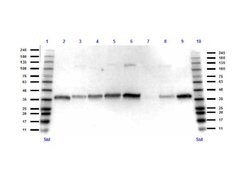Learn More
GAPDH Polyclonal Antibody, Rockland™


Rabbit Polyclonal Antibody
Supplier: Rockland Immunochemicals 600401GV0

Description
Store vial at -20°C prior to opening. Aliquot contents and freeze at -20°C or below for extended storage. Avoid cycles of freezing and thawing. Centrifuge product if not completely clear after standing at room temperature. This product is stable for several weeks at 4°C as an undiluted liquid. Dilute only prior to immediate use. Anti-GAPDH Antibody is directed against human GAPDH protein. A BLAST analysis was used to suggest that this antibody would react with GAPDH from a wide range of organisms, including most vertebrates and some yeast. Broad reactivity makes this antibody an excellent loading control.
GAPDH (Glyceraldehyde-3-phosphate dehydrogenase) is a catalytic enzyme commonly known to be involved in glycolysis. GAPDH exists as a tetramer of identical 37-kDa subunits and catalyzes the reversible reduction of 1,3-bisphosphoglycerate to glyceraldehyde 3-phosphophate in the presence of NADPH. Apart from playing a key role in glycolysis, GAPDH is ubiquitously expressed and displays other activities unrelated to its glycolytic function. GAPDH is reported to be involved in the processes of DNA replication, DNA repair, nuclear RNA export, membrane fusion and microtubule bundling. Studies provide evidence of GAPDH playing an essential part in gene expression observed in apoptosis and as part of the cellular phenotype of age-related neurodegenerative diseases. Further, GAPDH is involved in other cellular processes ranging from membrane fusion, and neuronal apoptosis in cancer. GAPDH is reported to bind to a variety of other proteins, including the amyloid precursor protein, mutations in which cause some forms of Alzheimer's disease (AD), and the polyglutamine tracts of Huntingtin, the protein product aberrant forms of which are causative of Huntington's disease. Associations between GAPDH, actin and tubulin have also be reported. Since GAPDH is expressed at high levels in most tissues, it is useful as protein loading control in Western Blot analysis.Specifications
| GAPDH | |
| Polyclonal | |
| Unconjugated | |
| GAPDH | |
| 38 kDa BFA-dependent ADP-ribosylation substrate; aging-associated gene 9 protein; BARS-38; bb02e05; BOS_17541; BOS_5957; cb350; cb609; CDABP0047; EC 1.2.1.12; epididymis secretory protein Li 278; epididymis secretory sperm binding protein Li 162eP; fb71f08; fk58c09; G3PD; G3PDH; Gapd; GAPD2; Gapdh; GAPDH2; gapdh-2; Gapdhs; GAPDS; Gapd-s; glyceraldehyde 3-phosphate dehydrogenase; glyceraldehyde 3-phosphate dehydrogenase, testis-specific; glyceraldehyde phosphate dehydrogenase; Glyceraldehyde-3-phosphate dehydrogenase; Glyceraldehyde-3-phosphate dehydrogenase 2; glyceraldehyde-3-phosphate dehydrogenase GAPDH; glyceraldehyde-3-phosphate dehydrogenase type 2; glyceraldehyde-3-phosphate dehydrogenase, spermatogenic; Glyceraldehyde-3-phosphate dehydrogenase, testis-specific; HEL-S-162eP; HEL-S-278; HGNC:4141; HSD35; HSD-35; I79_001391; KNC-NDS6; mg:bb02e05; MGC88685; OK/SW-cl.12; Peptidyl-cysteine S-nitrosylase GAPDH; Spermatogenic cell-specific glyceraldehyde 3-phosphate dehydrogenase 2; Sp | |
| Rabbit | |
| RUO | |
| 14433, 14447, 2597, 26330 | |
| -20°C, Avoid Freeze/Thaw Cycles | |
| Liquid |
| ELISA, Immunoprecipitation, Western Blot | |
| 1.08 mg/mL | |
| 0.02M potassium phosphate with 0.15M NaCl and 0.01% sodium azide; pH 7.2 | |
| O14556, P04406, P16858, Q64467 | |
| GAPDH, GAPDHS | |
| 100 μg | |
| Primary | |
| Human, Mouse | |
| Antibody |
The Fisher Scientific Encompass Program offers items which are not part of our distribution portfolio. These products typically do not have pictures or detailed descriptions. However, we are committed to improving your shopping experience. Please use the form below to provide feedback related to the content on this product.
